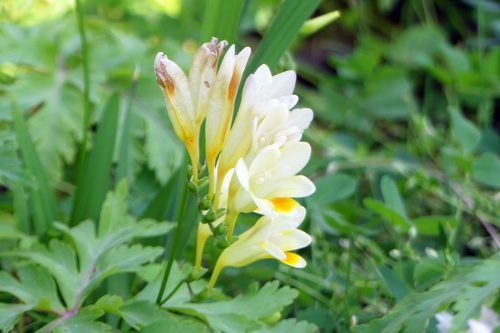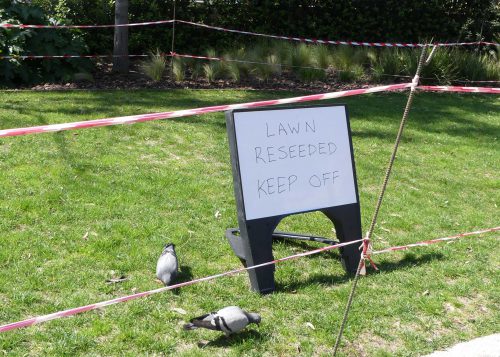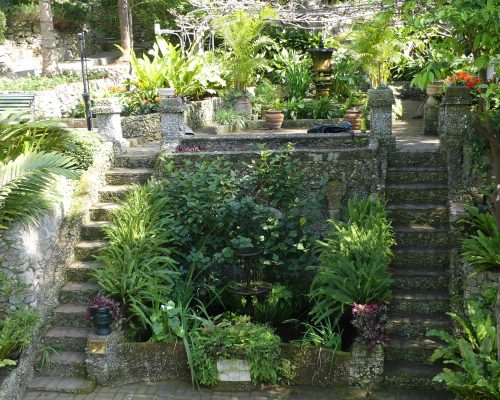March 20th-Day 2 afternoon- A walk to the Alameda Gardens via Commonwealth Park and the Trafalgar Cemetery
During the day the lower parts of Gibraltar are hectic and noisy with traffic. Most people drive everywhere, take the bus or hire a taxi, so in this small place with a large population, traffic is heavy and subsequent noise levels high. The drone of the constant streams of cars is punctuated with frequent horn-tootings and the waspish buzz of swarms of scooters dodging around them adds another dimension. Noise levels are further echoed and amplified by the proximity of the Rock itself, by the high old sea walls that bound the old town and by the ranks of the tall modern buildings that line the roads. Despite all this, as this fairly short walk shows, there are calm and peaceful oases to be found, busy roads are fringed with beautiful trees and looking upwards, the Upper Rock is cloaked with a mantle that is evergreen.
I started my walk more or less at this small ‘desert-island’ of a roundabout and walked along Bishop Caruna Road to the next roundabout, then turned left onto a stretch of the roadway that travels around the base of the Rock, Queensway Road.
COMMONWEALTH PARK
After about half a mile or so (approx. 600m), or around 12 minutes of walking, I left the noisy pavement to take the scenic route through the green and peaceful haven of Commonwealth Park. Opened in June 2014, this is the first public park to have been built in Gibraltar since the Alameda Gardens opened in 1816. Flanked by the old city walls the park has been thoughtfully landscape with large open grassy spaces, plenty of trees for shade and a large ornamental pool as well as planted gardens and it has matured into a lovely space that is well used and appreciated.
The Park’s visitors are not just restricted to human ones, the water is particularly attractive to birds too. House Sparrows enjoy it all year round and White Wagtails skitter around on the grass chasing flies, but a number of birds not commonly seen in Gibraltar have been spotted here too, including the occasional Egret and this past winter saw the arrival of a Cormorant who stayed around until he had eaten most of the larger fish in the pool! Recent records state that a Woodchat Shrike was seen here on April 1st.
I didn’t take many photographs here as there were quite a few people out enjoying the sunshine and I didn’t want to intrude on their peace. I ‘borrowed’ the picture above from the official visitor website. I found the scene below quite amusing though, and couldn’t resist photographing the cheeky pigeons disregarding the sign.
Striped-neck Terrapins had scrambled out of the ornamental pool to sunbathe on a small island of rounded boulders and seemed perfectly happy to pose.
I left the Park at its far end to rejoin Queensway Road and carried on walking to the Ragged Staff Gate, turning left onto Ragged Staff Road. From here it’s a short distance to Trafalgar Road and my next destination, which was the Trafalgar Cemetery. (If you follow written or map directions here it seems complicated to find as its at the junction of several roads, but basically it is right in front of you and you can’t miss it.)
trafalgar cemetery
The Trafalgar Cemetery is a peaceful haven for both those laid to rest there and for visitors seeking out its history or a calm place to escape a while from the nearby hustle and bustle. It is immaculately maintained and the old graves are shaded by a variety of beautiful trees and shrubs.
 The cemetery was consecrated in June 1798, seven years before the battle of Trafalgar. Known then as the Southport Ditch Cemetery, it may have been a part of the old St. Jago’s Cemetery, which was situated on the other side of Charles V Wall. The association with the battle of Trafalgar does not seem to have been made until many years after the event.
The cemetery was consecrated in June 1798, seven years before the battle of Trafalgar. Known then as the Southport Ditch Cemetery, it may have been a part of the old St. Jago’s Cemetery, which was situated on the other side of Charles V Wall. The association with the battle of Trafalgar does not seem to have been made until many years after the event.
The cemetery was used for burials between 1798 and 1814, then fell into disuse. Earlier gravestones from St.Jago’s cemetery were set into the eastern wall in 1932, and a few free-standing stones, some of which date back to the 1780s, have been transferred here over the years from the Alameda Gardens.
Although the name of the cemetery commemorates the Battle of Trafalgar, only two of those who are buried here actually died of wounds suffered in the battle (Lieut. William Forster of the Royal Marine Corps of H.M.S. Mars and Lieut. Thomas Norman of H.M.S. Columbus). Most of those who died at Trafalgar were buried at sea, and Lord Nelson’s body was transported to London for a state funeral.
The warm air was fragranced with orange blossom, a male blackbird sang while a female foraged beneath the trees and a chiffchaff was calling his namesake tune from a tall tree.
I saw my first butterfly of this trip here, a pretty fresh Speckled Wood. A similar species to our northern European butterfly of the same name, but a rich orange replaces the cream on the wings.
THE WINDSOR SUSPENSION BRIDGE
Leaving the Cemetery I crossed the road in front of me, walked a short distance then crossed Elliots Way (the road that goes up to the Upper Rock) to the car park, within which is located the Cable Car Base Station. The main entrance to the Alameda Gardens is at its far end. Looking up at the Upper Rock from here I stopped to photograph its new feature, the Windsor Bridge, Gibraltar’s first suspension bridge, which opened to the public in June 2016. Forming part of the Thrill Seekers Trail of the Upper Rock, the bridge is located between two Batteries, constructed over a 50 metre gorge and is 71 metre long.
the alameda – gibraltar botanic gardens
A BRIEF HISTORY
The Botanic Gardens cover an area of around 6 hectares (15 acres); the site was a cemetery before the gardens were commissioned in 1816 by the then British Governor of Gibraltar General George Don. In 1815, considering that “there being no place of public recreation in this Garrison” he “was induced…to establish a walk around the Grand Parade, and form what is called in this country an Alameda, where the inhabitants might enjoy the air protected from the extreme heat of the sun”. Alameda is derived from the Spanish word “Alamo”, or White Poplar Populus alba, and old writings mention these trees growing along the Grand Parade.
To avoid the use of public expenditure the gardens were laid out with voluntary contributions, including some from the Amateur Theatre and monies raised by a series of public lotteries.
Following the 1970s the gardens had deteriorated and had fallen into a poor state. Since 1991, the restoration of the Alameda as a Botanic Garden has been in the hands of Wildlife (Gibraltar) Ltd., on contract to the Government of Gibraltar. The aim is to develop the gardens in ways that will enhance enjoyment, conservation and education, so that its future will be even richer than its past. In 1994 the gardens saw the addition of a zoo: the Alameda Wildlife Conservation Park.
The gardens are laid out with a network of interconnecting paths leading around water features and terraced beds built from the local Jurassic limestone. The planting includes Mediterranean species, including some endemic to Gibraltar. There is also an African bed and an extensive cactus garden. At path junctions and in other strategic places are placed antique guns and other artillery that commemorate Gibraltar’s military heritage.
THE ELLIOTT MEMORIAL
A number of features were gradually added to the gardens, most reflecting historical facts or personalities. Entering through the main gates you are greeted by one of the oldest and the tallest of them; a memorial of George Augustus Eliott, 1st Baron Heathfield, guarded by four 18th-century howitzers (canons).
The statue was photographed from behind as I spotted a cheeky juvenile Yellow-legged gull perched on top of the General’s head.
THE DELL BRIDGE
A favourite feature of mine is the bridge with its attractive pergola tunnel, presently shaded with flowering Bougainvillea, that spans the Dell and Sunken Garden. I like the patterns the pergola and railings make on the paving of the bridge. It also affords good views down onto the sunken gardens of the Dell.
The bridge is named for Guiseppe Codali who was the head gardener and horticulturalist of the Gardens during the mid-19th Century. He was Italian, from Bergamo and was brought to Gibraltar specifically to work in the gardens. His Italian influence can be seen particularly in the bridge and sunken garden, The Dell, in the centre of the Alameda which was opened on the 24th September 1842 and re-inaugurated 150 years later on 24th September 1992.
THE WHALEBONE ARCH
This pair of whale jaw bones was originally placed at one end of the Dell Bridge. Their origin is long forgotten , but whalers regularly called into Gibraltar until the early 20th Century. The bones now form an arch over the gate leading into the Dell.
THE DELL OR SUNKEN GARDEN
Stripe-necked Terrapins stack up to enjoy the sunshine on the edge of a pool in the Dell.
PLANTS OF THE GARDENS
The plants of the Alameda Gardens are a combination of native species and others brought in from abroad, often from former British territories like Australia and South Africa with which Gibraltar had maritime links at the time of the British Empire. Since 1991 many new species have been planted, some growing in Gibraltar for the first time.

Fressia is a naturalised plant in Gibraltar and found growing in the wild. Here it is the Wildflower Garden
SOME PERSONAL FAVOURITE PLANTS
There are so many beautiful plants here it takes many visits to appreciate them properly, but here are some of my personal favourites.
The gardens have a stunning collection of Dragon Trees Dracaena draco, the oldest of which is over 200 years old, perhaps as much as 300, and would have been amongst trees here that pre-date the opening of the gardens. It is still young though, there are claims that they live upwards of 1000 years! An unusual member of the lily family The Dragon Tree comes from the Atlantic Islands of the Canaries, Madeira and Cape Verde. The smooth grey bark is reminiscent of an elephant’s hide and its red resin, which quickly crystalises, was used medicinally and known as Dragon’s Blood. Its panicles of showy white flowers appear irregularly in summer and produce bright orange berry-like fruit in winter.
There are Bird of Paradise plants, Strelitzia reginae, in several spots throughout the gardens. The species is originally native to South Africa and is the most exotic of flowers I think and so aptly named – I fancy this group looks just like a flock of large-billed birds about to take flight. Its scientific name commemorates the British queen Charlotte of Mecklenburg-Strelitz.
Another species of Strelitzia grows here too, it’s much larger and I think it may be S. nicolai , which is the largest in the genus, reaching as much as 10 m tall and producing stately white and blue flowers.The leaves are large and similar to a banana leaf in appearance. This beautifully newly-pruned tree shows the leaves grow in two ranks to form a fan-like crown of evergreen foliage. There is a flower bud squeezing between the leaf stems.
WILDLIFE OF THE GARDENS
The gardens are rich in wildlife. Bird species nesting here include Sardinian Warbler, Blackcap, Blackbird, Robin, Greenfinch, Serin and Wren. Winter additions include Grey and White Wagtail, Chifchaff, Black Redstart, Chaffinch, Short-toed Treecreeper and occasionally Kingfisher, while notable birds of passage periods are Hoopoe, Redstart, Woodchat Shrike and flycatchers. Kestrel (throughout the year) and Booted Eagle (in winter) regularly hunt in the grounds.
There is a small raised pond in the courtyard between the administration buildings and greenhouses where I caught a resident Perez’s frog – Pelophylax perezi basking in the sunshine.
Other wildlife that may be spotted are reptiles including the Moorish Gecko and Iberian Wall Lizard, Amphisbaenian and the harmless Horseshoe Whip Snake. Of the bats, the Pipistrelle is the commonest (often seen during the day), while Schreiber’s Bat and the European Free-tailed Bat can also be seen.
One of the gardeners here has an incredible talent for propegating plants and takes great pains to display stock plants in a perfectly ordered way. At one end of the pond is an immaculately arranged collection of cacti.
More cacti stand in a rank along a wall opposite a collection of various Aloes.
and finally for this visit, is a iew of part of his display of the epiphyte collection: a beautiful piece of living art.





































































